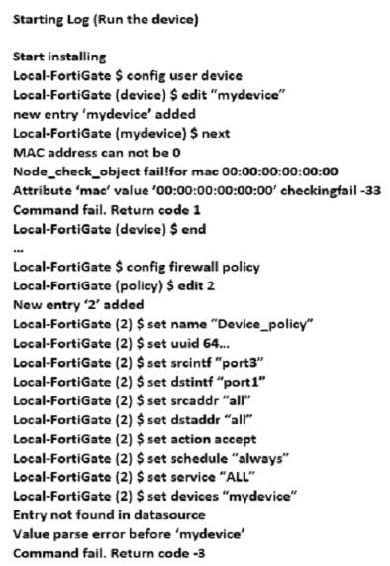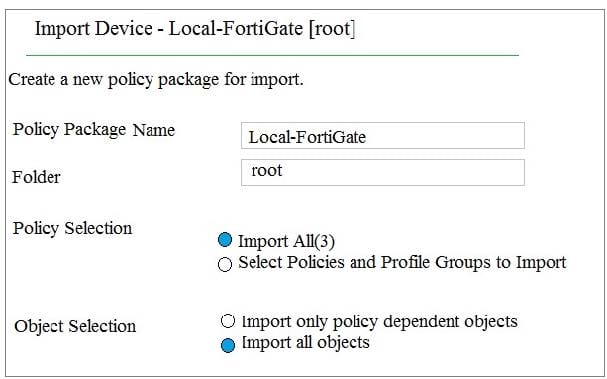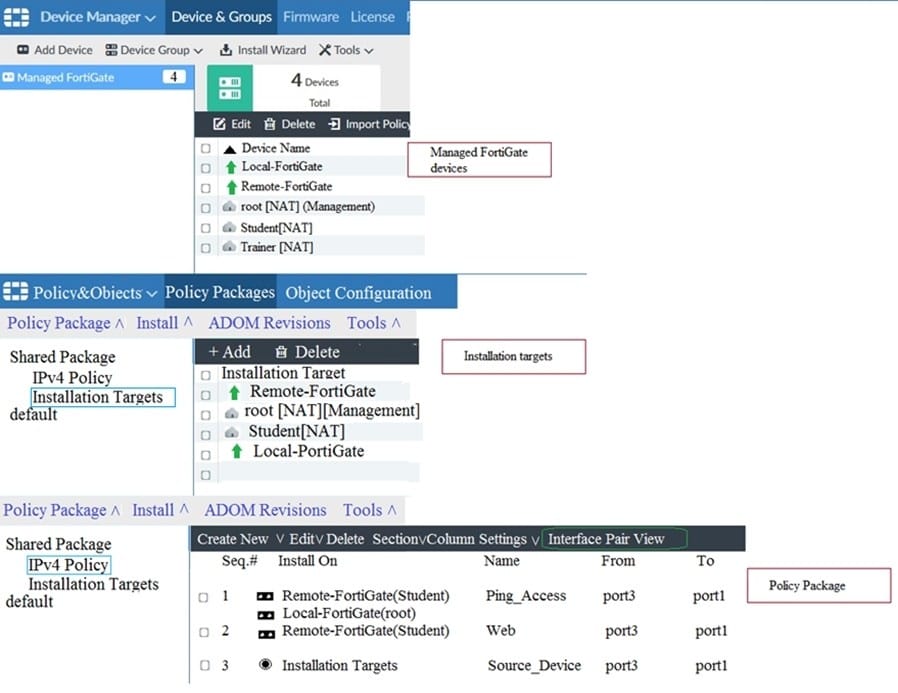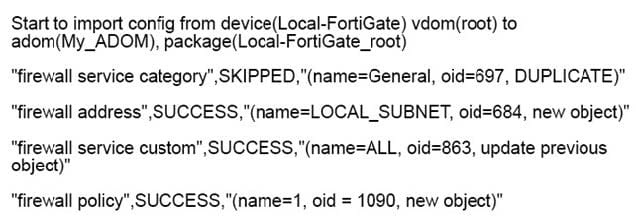Exam Details
Exam Code
:NSE5_FMG-7.0Exam Name
:Fortinet NSE 5 - FortiManager 7.0Certification
:Fortinet CertificationsVendor
:FortinetTotal Questions
:72 Q&AsLast Updated
:Aug 07, 2025
Fortinet Fortinet Certifications NSE5_FMG-7.0 Questions & Answers
-
Question 61:
Which two statements about the scheduled backup of FortiManager are true? (Choose two.)
A. It does not back up firmware images saved on FortiManager.
B. It can be configured using the CLI and GUI.
C. It backs up all devices and the FortiGuard database.
D. It supports FTP, SCP, and SFTP.
-
Question 62:
Which two conditions trigger FortiManager to create a new revision history? (Choose two.)
A. When configuration revision is reverted to previous revision in the revision history
B. When FortiManager installs device-level changes to a managed device
C. When FortiManager is auto-updated with configuration changes made directly on a managed device
D. When changes to device-level database is made on FortiManager
-
Question 63:
An administrator wants to delete an address object that is currently referenced in a firewall policy. What can the administrator expect to happen?
A. FortiManager will not allow the administrator to delete a referenced address object
B. FortiManager will disable the status of the referenced firewall policy
C. FortiManager will replace the deleted address object with the none address object in the referenced firewall policy
D. FortiManager will replace the deleted address object with all address object in the referenced firewall policy
-
Question 64:
View the following exhibit.

Which statement is true regarding this failed installation log?
A. Policy ID 2 is installed without a source address
B. Policy ID 2 will not be installed
C. Policy ID 2 is installed in disabled state
D. Policy ID 2 is installed without a source device
-
Question 65:
An administrator with the Super_User profile is unable to log in to FortiManager because of an authentication failure message. Which troubleshooting step should you take to resolve the issue?
A. Make sure FortiManager Access is enabled in the administrator profile
B. Make sure Offline Mode is disabled
C. Make sure the administrator IP address is part of the trusted hosts.
D. Make sure ADOMs are enabled and the administrator has access to the Global ADOM
-
Question 66:
Which two settings must be configured for SD-WAN Central Management? (Choose two.)
A. SD-WAN must be enabled on per-ADOM basis
B. You can create multiple SD-WAN interfaces per VDOM
C. When you configure an SD-WAN, you must specify at least two member interfaces.
D. The first step in creating an SD-WAN using FortiManager is to create two SD-WAN firewall policies.
-
Question 67:
View the following exhibit.

An administrator is importing a new device to FortiManager and has selected the shown options. What will happen if the administrator makes the changes and installs the modified policy package on this managed FortiGate?
A. The unused objects that are not tied to the firewall policies will be installed on FortiGate
B. The unused objects that are not tied to the firewall policies will remain as read-only locally on FortiGate
C. The unused objects that are not tied to the firewall policies locally on FortiGate will be deleted
D. The unused objects that are not tied to the firewall policies in policy package will be deleted from the FortiManager database
-
Question 68:
View the following exhibit.

Given the configurations shown in the exhibit, what can you conclude from the installation targets in the Install On column?
A. The Install On column value represents successful installation on the managed devices
B. Policy seq#3 will be installed on all managed devices and VDOMs that are listed under Installation Targets
C. Policy seq#3 will be installed on the Trainer[NAT] VDOM only
D. Policy seq#3 will be not installed on any managed device
-
Question 69:
An administrator, Trainer, who is assigned the Super_User profile, is trying to approve a workflow session that was submitted by another administrator, Student. However, Trainer is unable to approve the workflow session. What can prevent an admin account that has Super_User rights over the device from approving a workflow session?

A. Trainer is not a part of workflow approval group
B. Trainer does not have full rights over this ADOM
C. Trainer must close Student's workflow session before approving the request
D. Student, who submitted the workflow session, must first self-approve the request
-
Question 70:
Refer to the exhibit.

Which statement about the object named ALL is true?
A. FortiManager updated the object ALL using the FortiGate value in its database.
B. FortiManager installed the object ALL with the updated value.
C. FortiManager created the object ALL as a unique entity in its database, which can be only used by this managed FortiGate.
D. FortiManager updated the object ALL using the FortiManager value in its database.
Related Exams:
FCP_FAZ_AD-7.4
FCP - FortiAnalyzer 7.4 AdministratorFCP_FGT_AD-7.4
FCP - FortiGate 7.4 AdministratorFCP_FGT_AD-7.6
FortiGate 7.6 Administrator FCP_FGT_AD-7.6FCP_WCS_AD-7.4
FCP - AWS Cloud Security 7.4 AdministratorFCSS_EFW_AD-7.4
FCSS - Enterprise Firewall 7.4 AdministratorFCSS_NST_SE-7.4
FCSS - Network Security 7.4 Support EngineerFCSS_SASE_AD-24
FCSS - FortiSASE 24 AdministratorNSE4_FGT-5.6
Fortinet NSE 4 - FortiOS 5.6NSE4_FGT-6.0
Fortinet NSE 4 - FortiOS 6.0NSE4_FGT-6.4
Fortinet NSE 4 - FortiOS 6.4
Tips on How to Prepare for the Exams
Nowadays, the certification exams become more and more important and required by more and more enterprises when applying for a job. But how to prepare for the exam effectively? How to prepare for the exam in a short time with less efforts? How to get a ideal result and how to find the most reliable resources? Here on Vcedump.com, you will find all the answers. Vcedump.com provide not only Fortinet exam questions, answers and explanations but also complete assistance on your exam preparation and certification application. If you are confused on your NSE5_FMG-7.0 exam preparations and Fortinet certification application, do not hesitate to visit our Vcedump.com to find your solutions here.